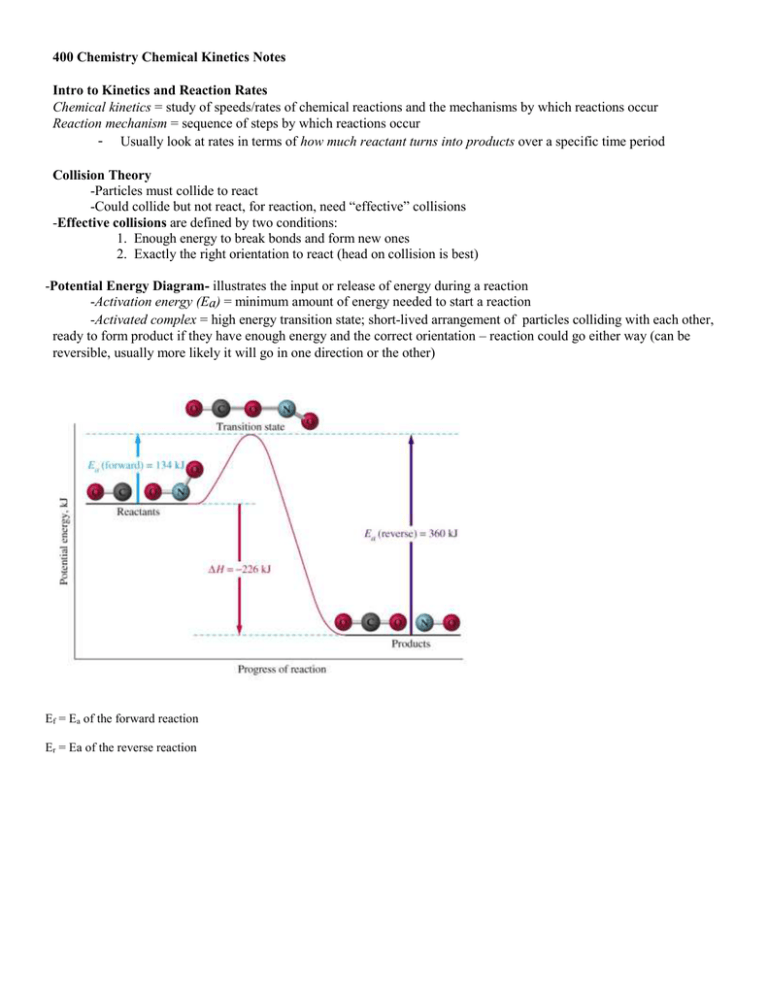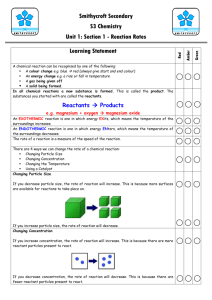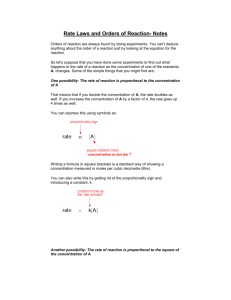400 Chemistry Chemical Kinetics Notes
advertisement

400 Chemistry Chemical Kinetics Notes Intro to Kinetics and Reaction Rates Chemical kinetics = study of speeds/rates of chemical reactions and the mechanisms by which reactions occur Reaction mechanism = sequence of steps by which reactions occur - Usually look at rates in terms of how much reactant turns into products over a specific time period Collision Theory -Particles must collide to react -Could collide but not react, for reaction, need “effective” collisions -Effective collisions are defined by two conditions: 1. Enough energy to break bonds and form new ones 2. Exactly the right orientation to react (head on collision is best) -Potential Energy Diagram- illustrates the input or release of energy during a reaction -Activation energy (Ea) = minimum amount of energy needed to start a reaction -Activated complex = high energy transition state; short-lived arrangement of particles colliding with each other, ready to form product if they have enough energy and the correct orientation – reaction could go either way (can be reversible, usually more likely it will go in one direction or the other) Ef = Ea of the forward reaction Er = Ea of the reverse reaction Note: to distinguish between them, use EF to mean the activation energy of the forward reaction and ER to mean the activation energy of the reverse reaction Make sure you understand and can label these graphs (reactants, products, activated complex, heat of reaction (∆Hrxn), activation energy, potential energy of activated complex, for forward and reverse reaction, etc.) ------------------------------------------------------------------------------------INCREASING REACTION RATES For any reaction to RUN faster, more effective collisions are required. There are 4 factors influence reaction rates. Four Factors that Influence Rates of Reactions 1) Temperature – A 10 deg Celsius increase in temperature causes a double rate for most reactions 2) Concentration 3) Catalyst 4) Nature of reactants 1. Temperature Recall, temperature is average kinetic energy. At a higher temperature, there are more effective collisions – more molecules have the activation energy needed to react. 2. Concentration More molecules = more chances for an effective collision. Metal Catalyst 3. Catalyst Catalyst = substance that lowers the activation energy by supplying an alternate route by which chemical reaction occurs while not being consumed in the reaction. A catalyst can be a metal, whose surface gives the reactants a place to react. 4. Nature of reactants/Physical state of the reactants Weak bonds = easier to break, reactants with weak bonds will react faster Strong bonds = harder to break, reactants with strong bonds will react slower Liquids and gases have a higher area of contact, but the inner atoms in a crystal lattice are blocked from reactants; therefore, the increased surface area of a solid will allow it to react faster. Specific Rate Laws Rate law – shows how the rate of a reaction depends on the concentration of reactants General rate law: Rate = k [reactants]a Where… R = rate of reaction, usually in Molarity/time (mol/(L x time)) k = specific rate constant – changes with temperature! DOES NOT ALWAYS HAVE THE SAME UNITS for each reaction! The units of the rate constant depend on the overall order of the reaction. “The rate constant is the answer to the question, "What fraction of the reactant molecules are traveling via this reaction pathway per unit time?" For example, if a rate constant is found to have the value 0.034 sec-1 (which is read as 0.034 per second), then 3.4% of the material in the source compartment travels by this pathway per second.” (from http://www.bioinformaticsservices.com/resources/faq/rateconst.html) [reactants] = concentration of the reactants in M (mol/L) a = rate order (a = 0 means “zeroth order”, a = 1 “first order”, a = 2 “second order) Note: The reaction stoichiometry does NOT determine the reaction order. Overall reaction order: the sum of all the individual orders --------------------------------------------------------------------------We can determine the specific rate law for a reaction 3 ways: 1. Experimental data 2. Chemical mechanism 3. Graphing techniques (AP & beyond) Determining the rate law using experimental data The Method of Initial Rates (from http://www.chem.ufl.edu/~itl/4411/lectures/lec_l.html) Consider a reaction A + B -> Products (this time we know the reaction is NOT elementary). An experimenter prepares several reaction mixtures and determines the initial reaction rates under these different conditions. The data obtained for several experimental runs in tabulated below Run # Initial [A] ([A]0) Initial [B] ([B]0) Initial Rate (v0) 1 1.00 M 1.00 M 1.25 x 10-2 M/s 2 1.00 M 2.00 M 2.5 x 10-2 M/s 3 2.00 M 2.00 M 2.5 x 10-2 M/s What is the rate constant for this reaction? ANS: Before we do anything, we must determine the order of the reaction with respect to every reactant, i.e. we must determine the rate law for the reaction. In the above example, the order can be easily determined by inspection. Method: Find a pair of experimental runs that the concentration of only one reactant changes. This is called the method of isolation and a good experimental design always has one such pair of experimetal runs. We can see that in runs 1 and 2, only the initial concentration of B has been varied. In fact, [B] 0 has doubled from run 1 to run 2 and the reaction rate has also doubled. Therefore the reaction must be First Order in B. Examination of runs 2 and 3 show that in these experimenal runs the concentration dependence of A has been isolated. In this case the doubling of the initial concentration of A has No EFFECT on the reaction rate so the reaction must be Zeroth Order in A. Thus the rate law for the reaction is rate = k[B]1[A]0 = k[B] Now, the rate constant can be determined from any of the experimental runs. Let's use run # 3 rate = 2.5 x 10-2 M/s= k (2.0 M) k = 1.25 x 10-2 s-1 Note that the initial rate of any expermental run (any prepared experimental condition) can now be determined (calculated) since we have the rate law and the rate constant. A More Complicated Example Consider a reaction A + B + C-> Products (this, too, is not an elementary reaction). Several initial conditions of this reaction are investigated and the following data are obtained: Run # [A]0 [B]0 [C]0 v0 1 0.151 M 0.213 M 0.398 M 0.480 M/s 2 0.251 M 0.105 M 0.325 M 0.356 M/s 3 0.151 M 0.213 M 0.525 M 1.102 M/s 4 0.151 M 0.250 M 0.480 M 0.988 M/s What is the initial rate of the reaction when all the reactants are at 0.100 M concentrations? ANS: First we must determine the rate law for the reaction, then the rate constant and then evaluate the rate law under the desired conditions. Method: Isolate the effect of the concentration of one of the reactants. In runs number 1 and 3, the only change of initial concentrations is that of reactant C, a change from 0.398 M to 0.525 M with a change in rate from 0.480 M/s to 1.102 M/s. These numbers are not so easy as to be able to guess the order by inspection, so lets think mathematically. If we define the order of the reaction in reactantys A, B, and C as a, b, and c, we can write down the rate law (with unknown orders) rate = k [A]a [B]b [C]c The ratio of the initial rates of runs 1 and 3 is then: Note that we have chosen this ratio so that many terms on the right hand side cancel, i.e. k and the concentrations of species A and B. The ratio reduces to: Note that none of the numbers in this equation have any units anymore because we have divided them out in a dimensionless ratio. Now, how to solve for c? Take the natural log (i.e. ln) of both sides of the equation or So the reaction is Third Order in reagent C! To continue, we pick another pair of runs that have a change in the initial concetration of C and just one other reactant. Let us choose the runs 1 and 4. The ratio of the initial rates of these runs is: Note that everthing cancels, is known, or is the order b. So: We can determine b as before by taking the ln of both sides of this equation: and b = 1.00. The reaction is First Order in B! Now that we know the order of Reactants A and B, we can use another pair of experimental runs to determine the remaining unknown order. We must use a pair of runs where the initial concentration of A changes, so we pick runs 1 and 2. As before, the ratio of initial rates is The rate constant cancels as before and we can solve for a: and, as usual, take the ln of both sides: which results in a = 2.00 and the reaction is Second Order in A. The rate constant for the reaction may now be evaluated from any of the experimental runs: or k = 1.57 x 103 l5 / mol5.s These units are appropriate for a reaction that is sixth order overall. Use another experimental run to check your answer. If the rate law is correct, every experimental run will give the same value of the rate constant. And now for the finale. The rate of the reaction when all the reactants are 0.100 M is: Extra problems in the book: p. 598 (21, 22, 23, 24, 25) ----------------------------------------------------------------------------------------------------Reaction Mechanisms Mechanism = sequence of steps by which a reaction occurs Ex: for the overall reaction: H2 + Cl2 →2 HCl might expect a simple mechanism (drawing) In reality, it has been determined (through elaborate experiments) that the actual mechanism is as follows: Cl2 + UV photon →2 Cl· Cl· + H2 →HCl + H· Cl· + H· →HCl (slow) (fast) where H· is a free radical (contains an unpaired electron) (fast) The slow step of a reaction is the rate determining step Rate law for a reaction is written from the slow step mechanism R = k[reactants in slow step mechanism]a where a = their coefficients in the equation for the slow step – you can do this here and NOT using the Method of Initial rates because in the Method of Initial rates you do NOT know the rate determining step – you In our example, R = k[Cl2]1 Intermediate = substance formed in one step in a mechanism and consumed in a later step; intermediates are never included in rate laws (think: which ones are intermediates in our example above?) If an intermediate appears in the slow step, can use substitution to remove it from the rate law (not something you need to worry about now) Example: Overall reaction: 3W + 2X + 3Z →4D + 2E Can we get the rate law directly from this alone? Proposed mechanism: 2W + X →2D + A A + 2Z →D + E W + X + Z →D + E (slow) (fast) (fast) Addition of all steps in the mechanism must give the overall reaction (check and make sure it does) Are there any intermediates? If so, what? Rate = k[W]2[X]1 Rate law depends only on the slow step! Suppose we were given 2 mol W, 2 mol X, 2 mol Z in a 10 L box… considering the reaction and rate law given above…. 1. What happens to the reaction rate when the box size is decreased by ½ (final volume of box is 5 L)? 2. What happens to the reaction rate if the concentration of W is doubled? 3. What happens to the reaction rate if the concentration of X is doubled? 4. What happens to the reaction rate if the concentration of Z is doubled? 5. What would adding a catalyst do to the rate? Check your answers: 1. Rate goes up by a factor of 8 2. Rate goes up by a factor of 4 3. Rate doubles 4. Nothing 5. Speed it up ------------------------------------------------








